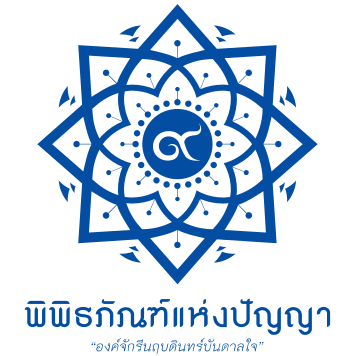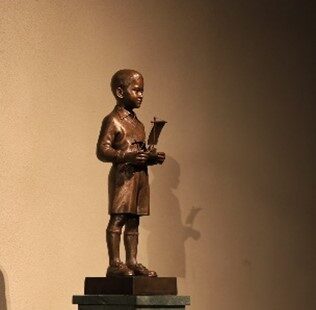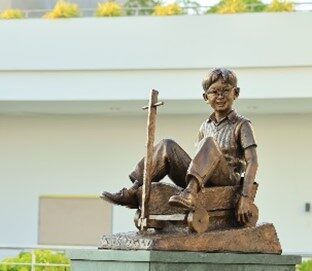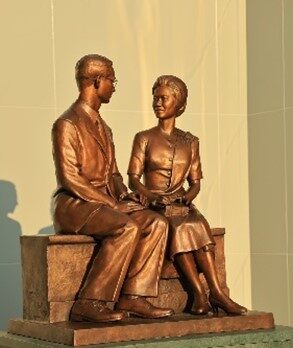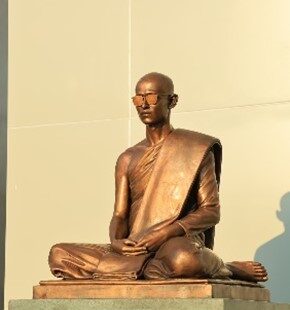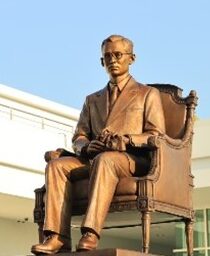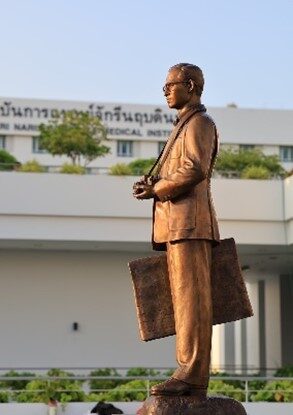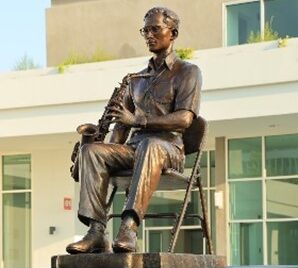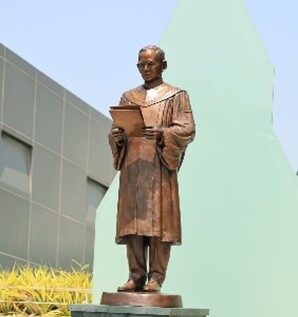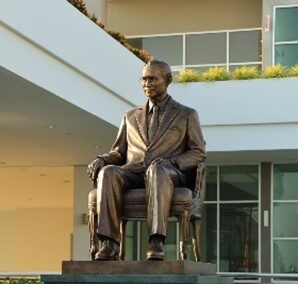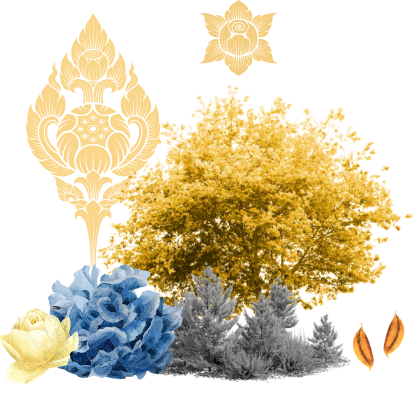
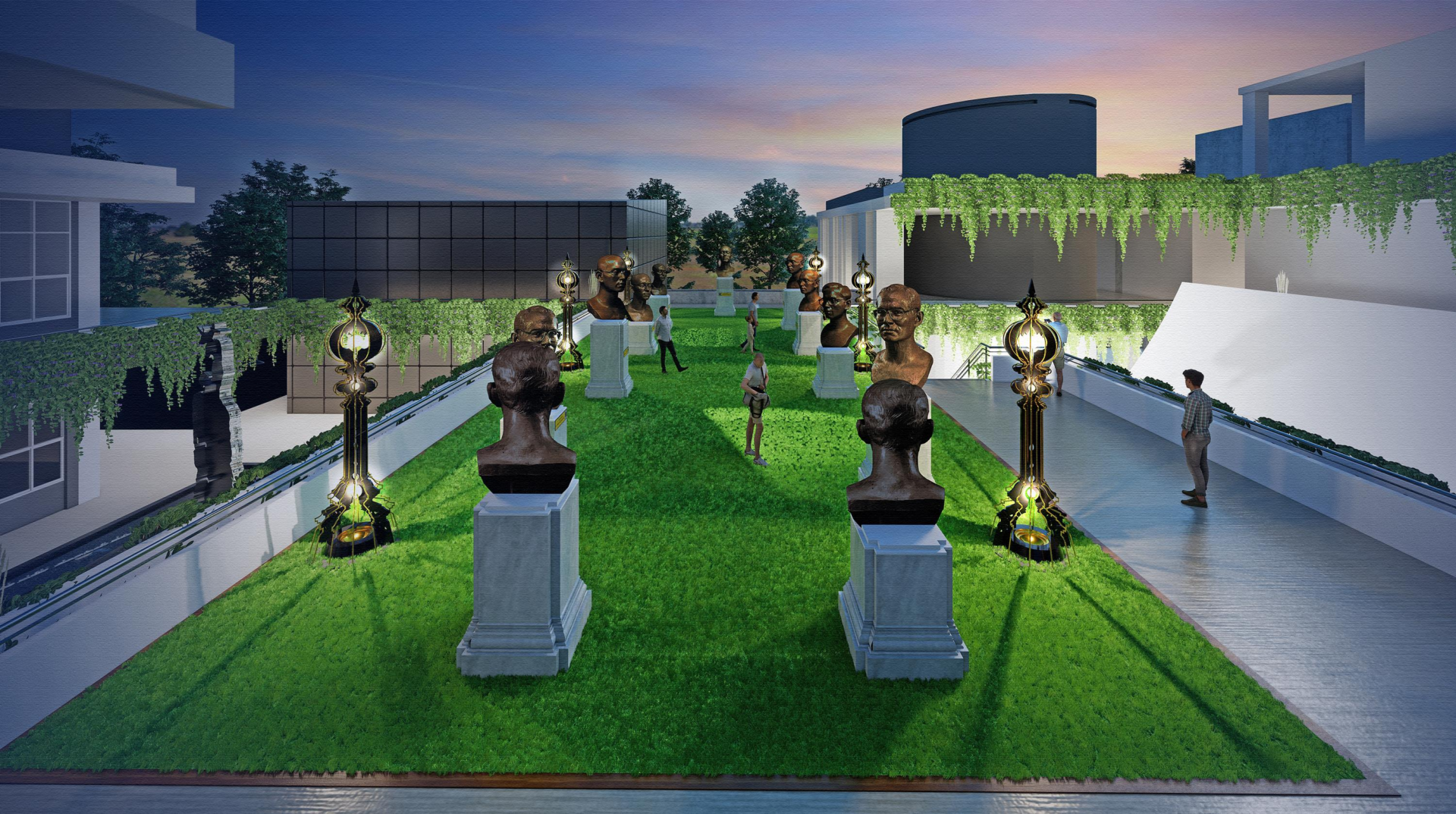
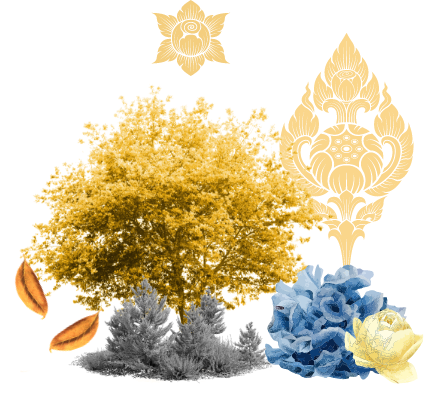
Zone 5
The "Three Characteristics: The Truth of Life"

Welcome to Zone 5, titled "Three Characteristics: The Truth of Life."
This area presents the core Buddhist principles that guide us to understand the nature of human life and all things: Anicca (impermanence), Dukkha (suffering), and Anatta (non-self). These teachings encourage spiritual awareness, helping us recognize that birth, aging, illness, and death are universal truths. This insight serves as a reminder to live mindfully, to act with virtue, and to avoid complacency.
In this exhibition, nine half-body sculptures of His Majesty King Bhumibol Adulyadej the Great are displayed, depicting different stages of his life, from childhood until shortly before his passing. These sculptures symbolize the natural transformations of the human form and serve as a reminder that, regardless of wealth, status, or title, no one escapes the “Three Characteristics.” Eventually, all must face the inevitable decay and dissolution, an enduring truth that applies to every life.
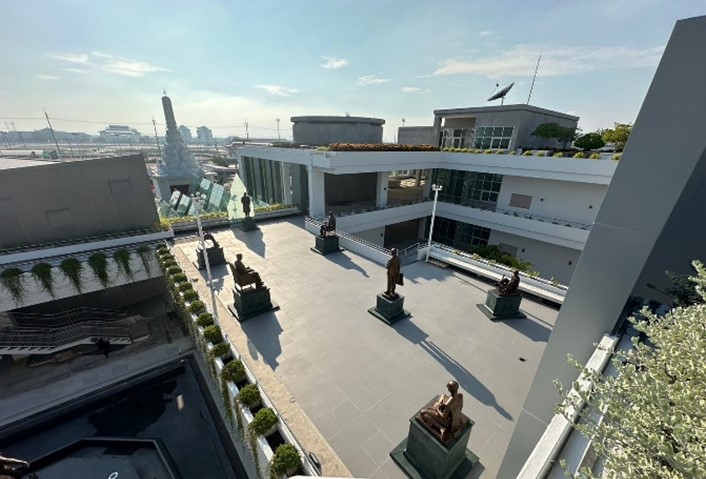
The "Three Characteristics" Sculpture Group
This sculpture group features realistic, life-size depictions of His Majesty King Bhumibol Adulyadej the Great in various postures, emphasizing his idealized yet familiar qualities. Slightly larger than life, these statues are set on bases that are lower than typical royal monuments, symbolizing his closeness to the people—just as his life was marked by his deep connection with them. Each sculpture captures facets of his royal life and character, from his interests, compassion, and growth to his health and everyday traits, highlighting his approachable and relatable nature as a beloved monarch.
Period 1: 1927 – 1936;
https://www.cnmimuseum.com/wp-content/uploads/Zone-2-4.png;
– On December 5, 1927, a baby boy with large, dark brown eyes was born at Cambridge Hospital in the state of Massachusetts, USA, on the morning of Monday, December 5, 1927.
||His Majesty King Bhumibol Adulyadej the Great, King Rama IX, was the son of His Royal Highness Prince Mahidol of Songkla and Mom Sangwan (her title at the time). He was born on Monday, December 5, 1927, at 8:45 a.m., which corresponded to the 12th waxing moon of the first lunar month in the Year of the Rabbit according to the Thai calendar. His birthplace was Cambridge Hospital (now Mount Auburn Hospital) in Boston, Massachusetts, USA.
Dr. W. Stewart Whittemore, who assisted with the birth, wrote by hand on the birth certificate: “Baby Songkla.” The father’s name was listed as Mahidol Songkla, occupation: medical student; and the mother’s name as Sangwan Talapat, occupation: housewife.
Less than three hours after the birth of his son, His Royal Highness Prince Mahidol of Songkla sent a telegram to Queen Savang Vadhana, stating: “A son was born this morning. Both are well. Kindly request a name via telegram.” Nine days later, King Prajadhipok (Rama VII) bestowed upon him the name “Bhumibol Adulyadej,” meaning “Strength of the Land, Incomparable Power.” He was given the title “Phra Worawongse Ther Phra Ong Chao Bhumibol Adulyadej,” though he was commonly referred to as “Phra Ong Lek” (the Little Prince).
– December 13, 1928: The family returned to Thailand for the first time.
||After His Royal Highness Prince Mahidol of Songkla completed his medical studies at Harvard University in the United States, he intended to undertake an internship at Siriraj Hospital and planned to permanently relocate his family to Thailand.
– September 24, 1931: His Royal Highness Prince Mahidol of Songkla passed away when King Bhumibol was only 1 year and 9 months old.
-1931: King Bhumibol began attending school for the first time at Mrs. Davies’ Kindergarten, a small school operated from a home in Bangkok.
– 1932: He transferred to Mater Dei School after Mrs. Davies’ Kindergarten closed.
– April 8, 1933: Following the political change in Thailand, the Mahidol family left for Europe under Queen Savang Vadhana’s guidance.
– December 9, 1933: The family arrived in Lausanne.
|||, Period 2: 1937 – 1946;
https://www.cnmimuseum.com/wp-content/uploads/Zone-5-0.jpg;
– 1937: His eyesight began to deteriorate, first noticed by his class teacher, who observed that he frequently had to stand up to copy from the blackboard. As a result, he had to wear glasses before the age of 10.
– 1937: He co-founded the “Patapoum Club.”
||His Majesty King Ananda Mahidol (Rama VIII) and His Majesty King Bhumibol Adulyadej the Great (Rama IX) co-founded the Patapoum Club to combine fun with charity. The club’s funds came from membership fees and other revenue-generating activities. Part of the membership fee came from the weekly allowance given by Her Royal Highness Princess Srinagarindra. If either received money as a gift, they were required to pay a tax to the club. Occasionally, they raised additional funds by selling raffle tickets with items from their possessions, with 50% of the proceeds set aside for charity.
– November 15, 1938, at 6:00 a.m.: They arrived at Si Chang Island and returned to Thailand along with His Majesty King Ananda Mahidol (Rama VIII).
– January 13, 1940 (according to the modern calendar): They returned to Switzerland to continue their studies.
– 1941: He saved money to buy a second-hand saxophone for 300 francs, using half of his personal savings (supported by the Patapoum Club), while Her Royal Highness Princess Srinagarindra covered the other half.
– 1945: He enrolled at the University of Lausanne, studying in the Faculty of Science.
– December 5, 1945: After World War II ended, he returned to Bangkok for the second time on his 18th birthday. Upon this return, he had grown into a distinguished young gentleman with gentle manners and kindness.
– April 1946: He composed his first song, “Saeng Thian” (Candlelight), at the age of 18.
– June 9, 1946, near 9:00 a.m.: His Majesty King Ananda Mahidol (Rama VIII) passed away.
||On the morning of June 9, 1946, one of the most devastating events in Thai history occurred when His Majesty King Ananda Mahidol (Rama VIII) suddenly passed away. The people of Thailand could hardly believe it was true. However, no sorrow could compare to the grief felt by His Royal Highness Prince Bhumibol Adulyadej (his title at that time), who lost both his brother and closest friend.
This tragic crisis not only shattered his heart but also completely changed his destiny. The National Assembly convened an emergency session and unanimously voted to invite His Royal Highness Prince Bhumibol Adulyadej to ascend the throne as King Rama IX of the Chakri Dynasty.
Despite the immense difficulty of coming to terms with life without his elder brother, life had to go on, leading him down a new path that would change forever.
– August 19, 1946: He bid farewell to his people before returning to Switzerland to continue his studies at the University of Lausanne. During this return, he made the sacrifice of giving up his beloved field of science in favor of studying governance.
||On August 19, 1946, His Majesty King Bhumibol Adulyadej gave a farewell address via radio broadcast before returning to Switzerland to continue his studies at the University of Lausanne. In his message, he said: “I must leave Thailand and all of you in order to further my education in new fields.”
At this time, he decided to switch from studying science to law, political science, and social sciences because he believed these subjects would be more beneficial for his royal duties as king.
|||, Period 3: 1947 – 1956;
https://www.cnmimuseum.com/wp-content/uploads/โซน-5-3-1.jpg;
– In 1948, while residing in Switzerland, His Majesty King Bhumibol Adulyadej the Great visited Paris to observe an automobile factory. He also attended a dinner at the Thai Embassy in Paris, where he met Mom Rajawongse Sirikit Kitiyakara, the daughter of His Serene Highness Prince Nakkhatra Mangkala Kitiyakara, the Thai Ambassador to France at the time, and Mom Luang Bua Kitiyakara, who was studying music in Paris. The following year, he became engaged to Mom Rajawongse Sirikit Kitiyakara in a private ceremony at the Windsor Hotel in Lausanne, Switzerland.
– In 1950, His Majesty returned to Thailand with his fiancée. He ordered a simple royal wedding ceremony to be held at Sra Pathum Palace on April 28, 1950, with Queen Savang Vadhana presiding over the event. On this occasion, His Majesty officially elevated Mom Rajawongse Sirikit Kitiyakara to the title of Queen Sirikit, marking the beginning of her role as his “Royal Consort” from that day forward.
|||, ช่วงที่ ๔:๒๕๐๐ – ๒๕๐๙;
https://www.cnmimuseum.com/wp-content/uploads/zone-5บวช.jpg;
– After 10 years of ascending to the throne
His Majesty King Bhumibol Adulyadej the Great developed a strong faith and determination to ordain as a monk in accordance with royal tradition. He entered the monkhood at the Chapel Royal of the Temple of the Emerald Buddha on October 22, 1956, and resided at Phanya Palace, Wat Bowonniwet Vihara, for 15 days. During his time as a monk, he strictly observed and practiced the Buddhist precepts, just like any other monk.
– After leaving the monkhood and resuming his royal duties as king
His Majesty continued to support and promote Buddhism while also extending royal patronage to all religions in Thailand. He was a righteous king who applied Buddhist principles in his personal conduct, governance, and duties. This virtuous approach yielded positive results throughout his reign, which became evident to all.
|||, Period 5: 1967 – 1976;
https://www.cnmimuseum.com/wp-content/uploads/zone-5-ถ่ายรูป.jpg;
– His Majesty King Bhumibol Adulyadej the Great had a passion for photography from a young age, likely inspired by his mother. After ascending to the throne, he continued to take photographs regularly, capturing portraits, family moments, landscapes, pets, and more. During his visits to different regions of Thailand, he photographed the people who came to greet him, as well as the landscapes, transportation routes, and views from both ground level and high mountains, as well as from his royal helicopter.
– His photographs were not only artistic but also held academic value and were used to benefit the development of the country and improve the lives of the people. As His Majesty once said
“…Photography is an art form; it is valuable and beneficial. Do not take photographs merely for fun or beauty. Use them to create value for society and benefit the public. Art can help advance the nation’s progress…”
– The many photographs taken by His Majesty throughout his royal duties were systematically archived. He graciously granted permission for them to be displayed in various photography exhibitions on special occasions. These photographs have become valuable records of Thailand’s social and national changes and remain cherished in the memories of the Thai people forever.
|||, Period 6: 1977 – 1986;
https://www.cnmimuseum.com/wp-content/uploads/zone-5-เล่นดนตรี.jpg;
– His Majesty King Bhumibol Adulyadej the Great was honored as the Supreme Artist due to his exceptional talent in almost every branch of the arts. He created numerous works that greatly benefited the nation, particularly in the field of music, which had captured his interest since childhood. His Majesty began learning and practicing music during his studies in Switzerland.
– His Majesty composed music from 1946 to 1995, writing a total of 48 songs. Some of his well-known compositions include Saeng Thian (Candlelight), Yam Yen (Evening), Sai Fon (Falling Rain), Klai Roong (Near Dawn), and Chata Chiwit (Life’s Destiny). Many of these songs were composed to inspire, give hope, provide comfort and encouragement, and bring joy to the people. Additionally, His Majesty used music as a means to strengthen international relations by performing with musical ensembles in countries he visited. This allowed the world to clearly witness his musical genius.
|||, Period 7: 1987 – 1997;
https://www.cnmimuseum.com/wp-content/uploads/zone-5-องค์ที่-7.jpg;
– “I shall reign with righteousness for the benefit and happiness of the Siamese people.” This was His Majesty’s first royal command, given during his coronation on May 5, 1950. Throughout his 70-year reign, the enduring image familiar to all Thais is of His Majesty King Bhumibol Adulyadej the Great traveling to remote and rural areas across every region of the country. He visited every corner, no matter how inaccessible, to personally care for the well-being of his people.
– His Majesty was determined to reach every destination, driven by a commitment to alleviate hardship and improve the quality of life for his subjects in all aspects. This dedication resulted in thousands of royal development projects. Even as he grew older, he never ceased working, ensuring that the Thai people would continue to benefit from his efforts, fulfilling the promise he made to them in every respect.
|||, Period 8: 1997 – 2006;
https://www.cnmimuseum.com/wp-content/uploads/zone-5-องค์ที่-8.jpg;
– On July 2, 1998 (the final year His Majesty presided over the graduation ceremony at Mahidol University), the brief moment when graduates received their diplomas from the King’s hand was a significant and memorable event that they would cherish for the rest of their lives. His Majesty first began conferring diplomas to graduates of the University of Medical Sciences, now Mahidol University, on April 3, 1950. From then on, he continued to preside over graduation ceremonies at numerous higher education institutions every year.
– His Majesty would spend many hours conferring diplomas to thousands of graduates. Although he experienced discomfort and physical strain from sitting for extended periods, he chose to overlook these feelings in order to honor and encourage each new graduate. His Majesty performed this royal duty for decades until, due to advancing age and health concerns, he had to cease this activity in 1999.
|||, Period 9: 2007 – 2016;
https://www.cnmimuseum.com/wp-content/uploads/zone-5-องค์ที่-9.jpg;
– In the final years of his life, His Majesty King Bhumibol Adulyadej the Great spent most of his time in the hospital receiving treatment for his illness. However, every moment of his life remained dedicated to his people. He continued to work tirelessly, always keeping a close watch on the affairs of the nation.
– Throughout his life, His Majesty reigned with righteousness and governed with genuine love for his people. Even after his passing, in accordance with the natural law of life, his virtues and good deeds remain deeply etched in the hearts of all Thai citizens forever.
|||
The Life and Legacy of His Majesty King Bhumibol Adulyadej the Great (1927–2016)
The sculpture series depicting the nine stages of life serves as a powerful reminder that all existence is bound by impermanence (Anicca), suffering (Dukkha), and the absence of self (Anatta). In essence, there is no true self; everything ultimately dissolves according to causes and conditions. Life, therefore, should be lived with mindfulness and caution, fostering inner peace and spiritual contentment. This state of mind reflects inner tranquility, resilience, acceptance of reality, purposefulness, hope, and satisfaction with one’s present life. It provides the strength to face life’s challenges and reinforces the importance of continuous virtue. Although the self may one day fade, good deeds endure. King Rama IX exemplifies this ideal, standing as a lasting model of goodness and integrity.

His Majesty's Dedication to Royal Duties for Over 70 Years
What His Majesty clearly demonstrated was his unwavering dedication to his royal duties for over 70 years as the head of state. He served as a role model for all of us, showing how we, as individuals with shared human qualities, can live lives that are beneficial both to ourselves and to others, during the time we are given until we eventually pass away.

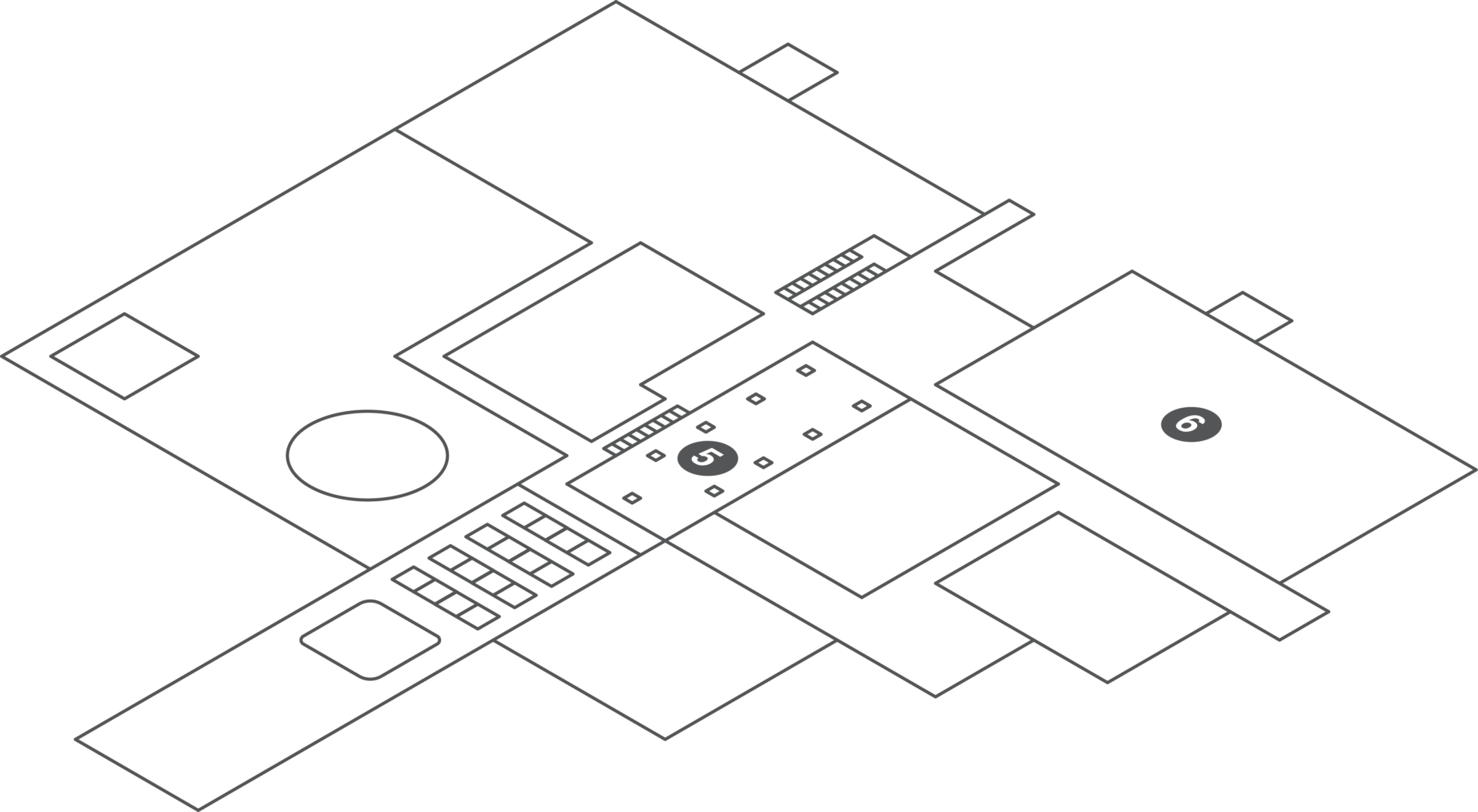
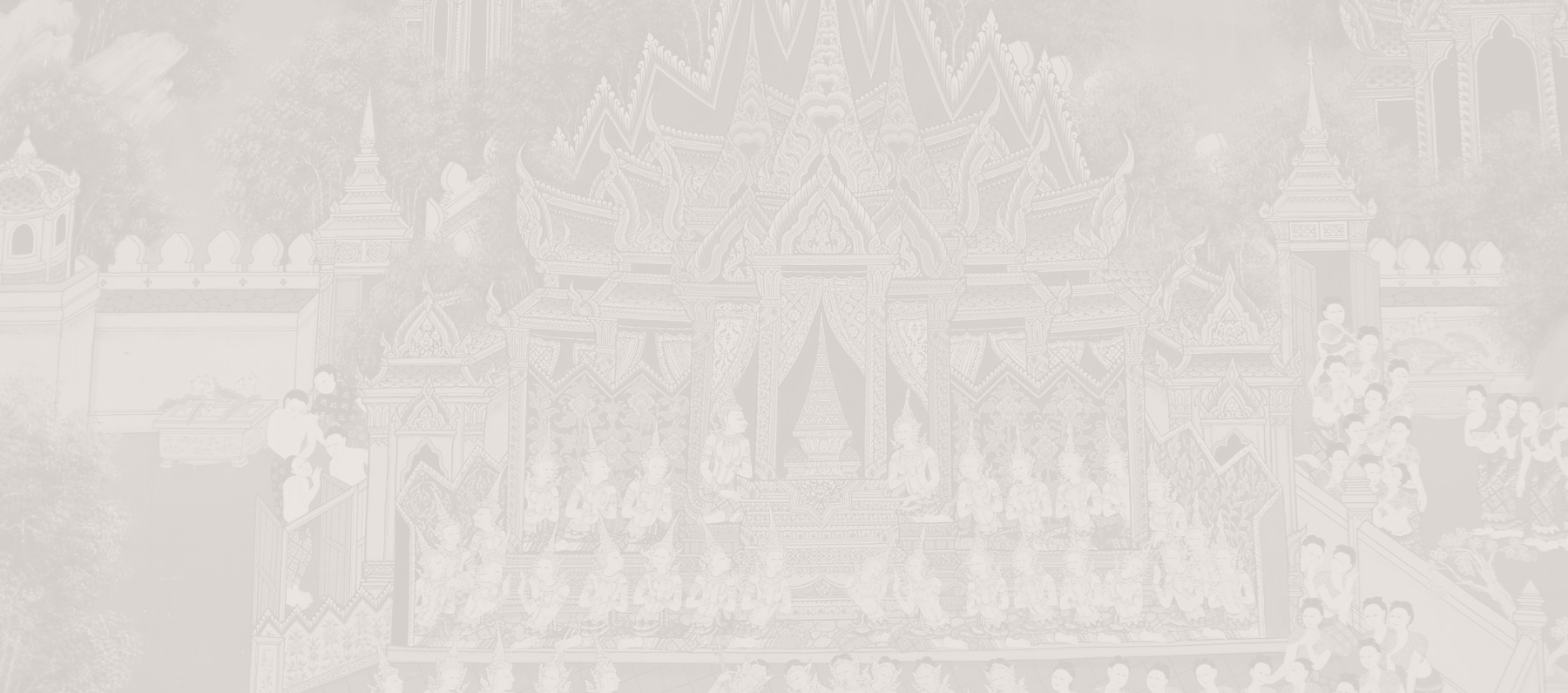

Exhibition Date and Time
Booking Form
For the general public, visiting hours are from 9:00 AM to 6:00 PM
Group Visits for International Visitors – Please Contact Our Staff
Contact
Chakri Naruebodindra Medical Institute
Faculty of Medicine Ramathibodi Hospital, Mahidol University
111 Liap Khlong Song Nam Suvarnabhumi Road, Bang Pla Subdistrict,
Bang Phli District, Samut Prakan 10540
contact us during business hours from 10:00 AM to 5:00 PM Tel 0 2839 6000
Lorem ipsum dolor sit amet, consectetur adipiscing elit.
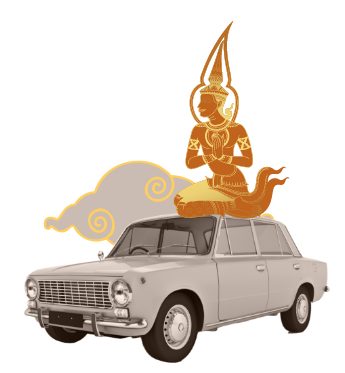
Ramathibodi Foundation
This foundation was established as a platform to publicize the Sukumo Foundation, a non-profit organization that promotes and supports education, sports, medicine, religion, and various charitable activities. On this occasion, it has supported the project to build the “Chakri Naruebodindra: Inspired Wisdom” Museum at Chakri Naruebodindra Medical Institute, Faculty of Medicine Ramathibodi Hospital, Mahidol University.

